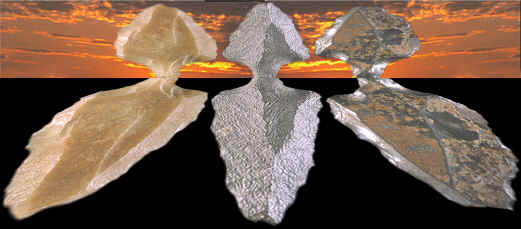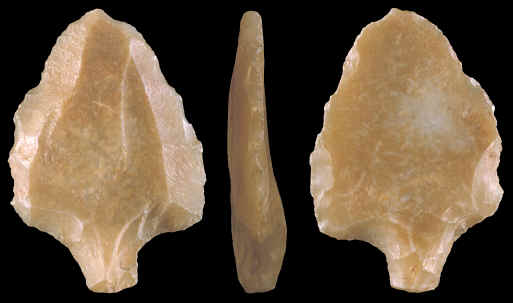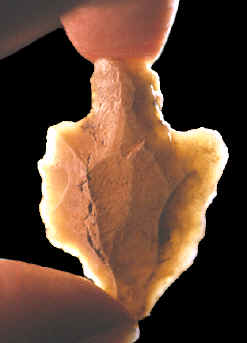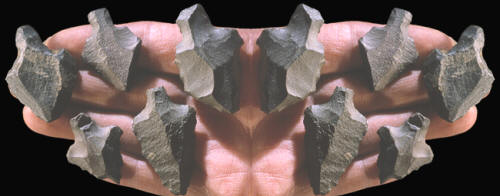|

|
|
abstract
TANGED ATERIAN POINTS
LATE MIDDLE PALEOLITHIC
MOROCCO, NORTH AFRICA
PRIVATE
COLLECTION
This article illustrates and describes several examples of Aterian
stemmed or tanged projectile points from Morocco in northwest Africa. The Aterian culture
dates to the late middle Paleolithic period, sometime before 40,000
years ago and came to an end about 30,000 years ago. Aterian points were developed
out of the Mousterian stone tool industry characterized by Levallois
technology. Large numbers of these points were made over a
wide area of North Africa. They were used to hunt many different
species of grazing animals such as
white
rhinoceros, extinct camel, gazelle and antelopes.
|
|
|
"The
Aterian industry has been recognized as such since 1919 when Reygasse
published the type site of Bir-el-Ater near Tebessa in Tunisia. The
following year he gave it the specific name"---1946,
G. Canton- Thompson, "The
Aterian Industry: Its Place And
Significance In The Paleolithic World,"
"The Aterian is one of the most widely distributed Paleolithic
industries of North Africa, extending from the Atlantic almost to the
Nile Valley and throughout much of the Sahara.".---1975,
C. Reid Ferring, "The Aterian In North Africa Prehistory," pp.
113-126.
"By 30,000 years ago a period of increasing desiccation (drying up)
in the Sahara led to the abandonment of most Aterian sites.".---1988,
Ian Tattersall, Eric Delson & John Van Couvering, "Encyclopedia
of human Evolution and Prehistory," p. 62
"(The
Aterian) is distinguished by the use of different kinds of tanged, or
stemmed, points, suitable for inserting into handles or attaching as
heads of spears, and similar projectiles."---1971,
J. Desmond Clark, "African Beginnings," p. 29.

ATERIAN POINTS
LATE MIDDLE PALEOLITHIC
NORTH AFRICA
The Aterian Industry was named after the type site called Bir el Ater
located in northwestern Africa in the country of Tunisia. The earliest
Aterian sites are believed to be well over 40,000 years old. An Aterian
kill site called BT-14, located 350 kilometers west of the Nile,
produced a carbon date from shell of 44,190 plus or minus 1,380 years.
Aterian sites end about 30,000 years ago when climate change forced the
abandonment of most sites when the grasslands of the Sahara began drying up.
|
|

CLICK ON
PICTURE FOR LARGE IMAGE
TANGED ATERIAN POINTS
LATE MIDDLE PALEOLITHIC
MOROCCO, NORTH AFRICA
PRIVATE COLLECTION
This picture shows a large number of tanged Aterian points that are
reported to have been collected on sites in southern Morocco. They
were all made from simple thick flakes struck from cores. Tanged
Aterian points are very heavy duty projectile points. The smaller
examples (they are reported up
to
8 or 9 inches (20 to 22 cm) long)
are
believed to have been hafted onto darts or spears that were thrown
by atlatls (spear throwers). These points were used to hunt large
grazing animals such as white rhinoceros, extinct
camels and large bovine (ox-like or cow-like). They were also
used to hunt smaller animals like gazelle, fox, jackal, warthog,
antelopes and ostrich. The points illustrated here were made from a
variety of different cherts and some that appear to be Basalt or
Rhyolite. They range in size from
2
5/8 inches (6.6 cm) long to 1 5/16 inches (3.3 cm) long. Thickness
ranges from 1/4 of an inch (5.5 mm) to 9/16 of an inch (1.4 cm). |
|
|
Aterian sites are found over a wide area of
North
Africa. In fact, C. Reid Ferring (1975) states that "The Aterian is
one of the most widely distributed Paleolithic industries of North
Africa." Aterian sites are found in Morocco to Tunisia in the
northwest and over much of the Sahara desert almost
to the Nile Valley of Egypt to the east.
|
|

CLICK ON
PICTURE FOR LARGE TRIPLE IMAGE
TANGED ATERIAN POINT
LATE MIDDLE PALEOLITHIC
MOROCCO, NORTH AFRICA
PRIVATE COLLECTION
This picture shows three views of a good representative example of a
tanged Aterian point. It was made on a thick flake that was trimmed
to a point on one end and notched on both sides of the
bulb-of-percussion on the other end to form the tang. The center
edge view shows the thicker bulb-of-percussion at the stem or tang
hafting element. This point was made from very good quality
semi-translucent chert that is represented by only 3.5 percent of
the 70 examples illustrated in this article. It's also heavily
patinated with desert varnish caused from wind blown sand. This
point measures 1 7/8 inches (4.8 cm) long, 1 1/4 inches (3.2 cm)
wide and 3/8 of an inch (9 mm) thick. |
|
|
The Aterian industry developed out of Mousterian stone tool
technology. Their blades were produced from cores made with Levallois
technology. It's interesting to note that most human fossils associated
with Mousterian industries are Neanderthals. But archaic modern humans
have been found associated with Mousterian sites from Morocco to Israel.
The Aterian people were using Neanderthal stone tool manufacturing techniques
but they themselves were probably early modern humans. Discoidal and
tortoise cores produced by Levallois technology is a more wasteful
process if compared to later core and blade technology that developed during
the Aurignacian period. But the older technology, as shown in the
archaeological record, worked quite well.
|
|

TANGED ATERIAN POINT
LATE MIDDLE PALEOLITHIC
MOROCCO, NORTH AFRICA
PRIVATE COLLECTION
This picture shows one of five or six examples of tanged Aterian
points, illustrated in this report, that were made from a fine
quality semi-translucent chert. This point measures 1 3/4
inches (4.4 cm cm) long, 1 3/16 inches (3 cm) wide and 3/8 of an
inch (9 mm) thick. |
|
|
Aterian tanged points are one of the oldest
types of projectile
points. The smaller examples are thought to have been used on darts or
spears that were thrown by atlatls. The issue has been controversial
though. Archaeologist like G. Canton-Thompson suggested, as early as
1946, that Aterian points were used on arrows. But, in recent
years, the most accepted device is the atlatl instead of the bow.
Archaeologist Michael A. Hoffman wrote in 1984, "----these
artifacts (Aterian points) seem at once too big and too bulky to have
been used as projectile points on primitive arrows. ----they were
probably employed as dart points in spear throwers, certainly not as
arrowheads."
|
|
CONTINUE ON TO PAGE
TWO
|
|
"REFERENCES"
1946,
Canton-Thompson, G., "The Aterian Industry: Its Place and
Significance In The Paleolithic World," The Huxley Memorial
Lecture for 1946, p.89.
1971,
Clark, J. Desmond, "African Beginnings," "The Horizon
History of Africa," p.29
1975, Ferring, C. Reid, "The Aterian In North African
Prehistory," "Problems In Prehistory: North Africa And The
Levant," pp. 113-126.
1975, Jelinek, J., "The Evolution of Man," p. 147.
1984, Hoffman, Michael A., "Egypt Before The Pharaohs,"
pp. 66-70.
1988, Tattersall, Ian, Delson, Eric & Couvering, John Van,
"Encyclopedia of human Evolution And Prehistory," p. 62.
|





